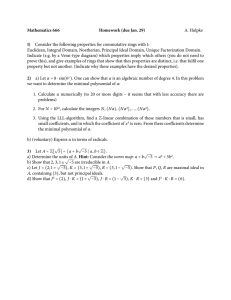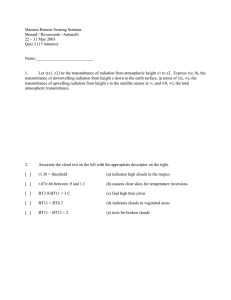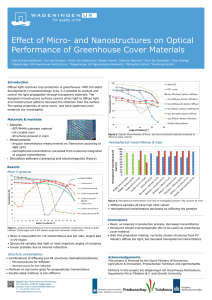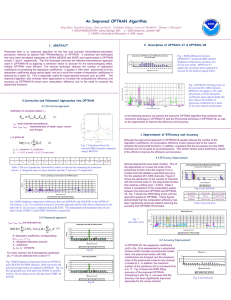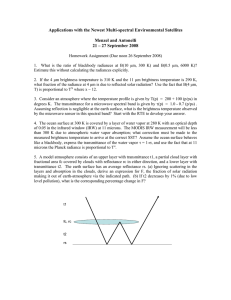An Improved OPTRAN Algorithm
advertisement
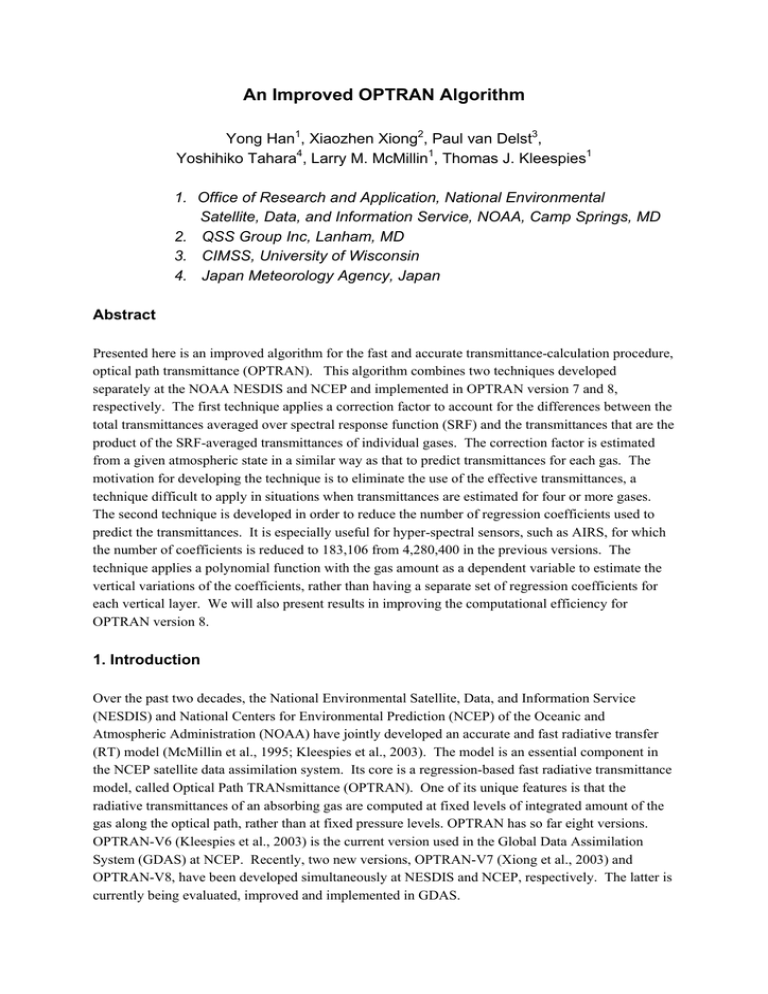
An Improved OPTRAN Algorithm
Yong Han1, Xiaozhen Xiong2, Paul van Delst3,
Yoshihiko Tahara4, Larry M. McMillin1, Thomas J. Kleespies1
1. Office of Research and Application, National Environmental
Satellite, Data, and Information Service, NOAA, Camp Springs, MD
2. QSS Group Inc, Lanham, MD
3. CIMSS, University of Wisconsin
4. Japan Meteorology Agency, Japan
Abstract
Presented here is an improved algorithm for the fast and accurate transmittance-calculation procedure,
optical path transmittance (OPTRAN). This algorithm combines two techniques developed
separately at the NOAA NESDIS and NCEP and implemented in OPTRAN version 7 and 8,
respectively. The first technique applies a correction factor to account for the differences between the
total transmittances averaged over spectral response function (SRF) and the transmittances that are the
product of the SRF-averaged transmittances of individual gases. The correction factor is estimated
from a given atmospheric state in a similar way as that to predict transmittances for each gas. The
motivation for developing the technique is to eliminate the use of the effective transmittances, a
technique difficult to apply in situations when transmittances are estimated for four or more gases.
The second technique is developed in order to reduce the number of regression coefficients used to
predict the transmittances. It is especially useful for hyper-spectral sensors, such as AIRS, for which
the number of coefficients is reduced to 183,106 from 4,280,400 in the previous versions. The
technique applies a polynomial function with the gas amount as a dependent variable to estimate the
vertical variations of the coefficients, rather than having a separate set of regression coefficients for
each vertical layer. We will also present results in improving the computational efficiency for
OPTRAN version 8.
1. Introduction
Over the past two decades, the National Environmental Satellite, Data, and Information Service
(NESDIS) and National Centers for Environmental Prediction (NCEP) of the Oceanic and
Atmospheric Administration (NOAA) have jointly developed an accurate and fast radiative transfer
(RT) model (McMillin et al., 1995; Kleespies et al., 2003). The model is an essential component in
the NCEP satellite data assimilation system. Its core is a regression-based fast radiative transmittance
model, called Optical Path TRANsmittance (OPTRAN). One of its unique features is that the
radiative transmittances of an absorbing gas are computed at fixed levels of integrated amount of the
gas along the optical path, rather than at fixed pressure levels. OPTRAN has so far eight versions.
OPTRAN-V6 (Kleespies et al., 2003) is the current version used in the Global Data Assimilation
System (GDAS) at NCEP. Recently, two new versions, OPTRAN-V7 (Xiong et al., 2003) and
OPTRAN-V8, have been developed simultaneously at NESDIS and NCEP, respectively. The latter is
currently being evaluated, improved and implemented in GDAS.
Both OPTRAN-V7 and -V8 are developed from OPTRAN-V6, which applies the effectivetransmittance technique to account for the instrumental band averaging effect and a fixed multi-layer
structure to estimate transmittances at fixed layers. OPTRAN-V7 has replaced the effectivetransmittance technique with the correction-factor technique. This change makes OPTRAN more
efficient and easier to be extended to include more variable gases. However, it requires the same 300layer structure as that used in OPTRAN-V6, which needs 300 regression equations and 1800
regression coefficients to estimate transmittances per gas and channel. The large number of regression
coefficients, however, is a problem for the current NCEP analysis system to assimilate data from
hyper-sensors such as AIRS, due to the limitation of the computer memory capacity. OPTRAN-V8
was initiated to solve the problem. It introduces a polynomial function to fit the absorption
coefficients along optical paths and thus does not require the multi-layer structure. As a result, the
number of regression coefficients is reduced by a factor of 23. However, OPTRAN-V8 still uses the
same effective transmittance technique as that used in OPTRAN-V6, and consequently is difficult to
be extended to include more variable gases.
In this paper we report the work to integrate OPTRAN-V7 and –V8 by implementing the correctionfactor technique into OPTRAN-V8. We also present results from the work to improve OPTRAN-V8
efficiency. We start with a brief description of OPTRAN-V7 and –V8, and then present the methods
and preliminary results, followed by a summary.
2. Description of OPTRAN-V7 and –V8
2.1 OPTRAN-V7
In OPTRAN-V7, the atmosphere is divided vertically into 300 layers along the optical path in the socalled absorber space. The absorber space is a set of discrete integrated gas amount {Ai, i=0, 300}
with A0 being the minimum value at the top of the atmosphere and A300 the maximum value at the
surface. Since three gas types are included in OPTRAN-V7, three absorber spaces are required. The
distribution of the levels in the absorber space has large impact on the accuracy of the transmittance
estimation (Xiong et al., 2003). Once determined, the absorber space is fixed and applied for any
cases. OPTRAN estimates gas transmittances, but they are not predicted directly. The absorption
coefficients is predicted directly using the following 5-predictor regression equation,
5
k i = ci , 0 + ∑ c i , j X i , j
(1),
j =1
where ki is the absorption coefficient at layer i , and {ci,j} and {Xi,j} are regression coefficients and the
predictors, respectively. Then, ki is converted to layer transmittance τi using
τ i = exp( −k i ( Ai − Ai −1 ))
(2).
Note that τi is the transmittance averaged over the frequency band with the instrument spectral
response function (SRF). The regression coefficient set {ci,j} in (1) is obtained from a statistical
atmospheric profile ensemble, in which both the dependent variable ki or τi and independent variable
Xi,j are calculated from the ensemble, with τi computed using a line-by-line model and the SRFs. The
predictor set {Xi,j, j=1,5} is selected from a pool of 18 pre-defined predictors. The total transmittance
τtot,i is a product of three gas transmittances, multiplied by a correction factor τc as (for simplicity the
layer index i is dropped),
τ tot = τ dryτ H 2Oτ O 3τ c
(3),
where τH2O and τO3 are the water vapor and ozone transmittances, respectively, and τdry is the so-called
dry gas transmittance, which includes the contributions from other absorbing gases such CO2 and CH4.
The function of τc is to correct the difference between the SRF-averaged total transmittance and the
product of individual SRF-averaged gas transmittances. Examples of the correction factors are shown
in Fig. 1.
The correction factor τc is estimated in the same way as that for the gas transmittances, by using (1)
and (2). The process also requires an absorber space. It is found that the water vapor absorber space
is a good choice for τc, although more complicated procedures may be adopted (Xiong et al., 2003).
Fig. 1 Correction factors for selected HIRS channels computed using LBLRTM (Clough et al.
1992)
2.2 OPTRAN-V8
In OPTRAN-V8, the multi-layer structure is no longer used. Instead, a single regression equation is
applied to predict transmittance at any level as
6
ln(k ( A)) = c0 ( A) + ∑ c j ( A) X j ( A) ,
(4)
j =1
where A is the absorber amount of the gas whose transmittances are estimated and cj(A) is given by a
polynomial function as
10
c j ( A) = ∑ a j ,m A m , j = 0,6
m =0
where {aj,m}is a set of constants. OPTRAN-V8 uses 6 predictors selected from a pool of 17 predefined predictors and a 10th order polynomial function. There are total 77 regression coefficients in
(4), which is a much smaller number compared with the 2400 coefficients, required by OPTRAN-V7.
In practice, instead of using the absorber amount A directly in (4), A is replaced by the following
variable,
Z=
1
α
ln(
A − b2
),0 ≤ Z ≤ 1
b1
(5),
where α is a constant determined by trial, and b1 and b2 are also constants determined by the
minimum and maximum values of the absorber amount A. The absorption coefficient kc in (4) is
related to transmittance by the same formula given by (2), but the transmittance is the effective
transmittance, defined in the following,
τ tot = τ dry *τ H 2O *τ O 3 * ,
(6),
where τH2O* , τO3* and τdry* are the effective transmittances of dry gas, water vapor and ozone,
respectively, given by
τ dry * = τ tot / τ H 2O +O 3 ,
τ H 2O * = τ H 2O ,
and
τ O 3 * = τ H 2O +O 3 / τ H 2O .
The main drawback of the effective-transmittance technique is that it is difficult to be applied for the
case in which there are more than three variable gases. In the following section we describe methods
to replace the effective-transmittance technique with the correction-factor technique.
3. Implementation of Correction-factor Technique into OPTRAN-V8
The correction-factor technique is first implemented in OPTRAN-V7. As mentioned in the previous
section, OPTRAN-V7 treats τc as a pseudo transmittance and predicts it in the same way as for the gas
transmittances. This treatment simplifies the computing process. With OPTRAN-V8, however, the
same treatment does not apply for the following reasons. First, since OPTRAN-V8 predicts ln(k), not
k, it is not valid to treat τc as a pseudo transmittance. Secondly, it is found that not all the polynomial
modes {Am, m=1,10} in the regression equation have significant contributions for predicting τc. The
insignificant modes should be dropped to benefit the computational stability. After many experiments,
the following regression equation is formulated,
n
ln(τ c ) = c0 + ∑ c j X j
(6),
j =1
where {ci, j=0, n} is a set of constants and {Xj, j=1,n} a subset of the 12 predictors listed in Table 1.
The accuracy of (6) has been evaluated and the results are shown in Fig. 2 and 3. In these figures, the
RMS accuracies are obtained by comparing the OPTRAN-based RT model with a line-by-line model.
Fig 2 shows the RMS brightness temperature differences for a subset of AIRS channels computed
from both the dependent (blue line) and independent (red line) databases, with the correction-factors
estimated using (6) and the gas transmittances calculated exactly. Fig. 3 shows the RMS differences
at the HIRS channels from the dependent (Fig. 3a) and independent (Fig. 3b) databases, with both the
correction factors and gas transmittances estimated. We see that errors in general are below the 0.1 K
level except a few ozone channels.
1
AH2O
i
Xi
2
AH2O2
3
AH2O3
4
AH2O4
5
AO3
6
AO32
7
AO33
8
AO34
9
P1/4
10
PT
11
AH2OPT
12
AO3PT
Table 1. The set of predictors, from which a subset is selected for estimating the correction
factors. A: integrated space-to-layer absorber amount; P: pressure; T: temperature.
Errors in predicting correction factors for 281 AIRS channels
0.3
RMS (K)
0.25
0.2
0.15
0.1
0.05
0
600
700
800
900
1000 1100 1200 1300 1400 1500 1600 1700 1800 1900 2000 2100 2200 2300 2400 2500 2600 2700
W avenumber (1/cm)
Independent s am ples
Dependent s am ples
Fig. 2 RMS brightness temperature differences between the OPTRAN-V8 based RT model
and the line-by-line mode LBLRTM at the selected 281 AIRS channels. The OPTRAN-V8
model has been modified to include the correction-factor technique. These are the errors
from the correction factor only. The gas transmittances are computed exactly using
LBLRTM. The independent (red) and dependent (blue) sample sets are based on the CIMSS
32 and UMBC 48 profiles, respectively
HIRS Fitting ERRORS
0.3
0.3
0.25
0.25
0.2
RMS (K)
RMS (K)
Independent test with 32 CIMSS profiles
0.15
0.1
0.05
0.2
0.15
0.1
0.05
0
0
1
2
3
4
5
6
Total
7
8
9
10 11 12 13 14 15 16 17 18 19
Fig.
3a number
HIRS channel
Ozone
Wet
Dry
Correction-factor
1
2
3
4
5
6
Total
7
8
9
10 11 12 13 14 15 16 17 18 19
Fig.
3b number
HIRS channel
Ozone
Wet
Dry
Correction-factor
Fig. 3 RMS brightness temperature differences between the OPTRAN-V8 based RT model
and the LBLRTM model at the HIRS channels. The OPTRAN-V8 model has been modified
to include the correction-factor technique. Fig 3a: the independent data set from the CIMSS
32 profiles; Fig 3b: the dependent data set from the UMBC 48 profiles. Yellow – errors from
ozone transmittances; brown – water vapor; blue – dry gas; red – correction factor; green –
total transmittances.
4. Efficiency Improvement
Although OPTRAN-V8 uses fewer regression coefficients than OPTRAN-V7, it requires more
computational time due to the need to evaluate various polynomial modes. One of the solutions to
improve its efficiency is to reduce the order of the polynomial functions under the condition not to
decrease the targeted accuracy. Experiment showed that not all transmittance calculations require a
10th order polynomial. For example, for the subset of AIRS channels, only less than 5% of the
transmittance calculations need the 10th order polynomial for a targeted fitting error of less than 0.05
K as shown in Fig. 6. Most of the calculations reach this accuracy with a third or second order
polynomial function. By varying the order of polynomial functions, we can improve the
computational efficiency substantially, as demonstrated in Table 2, which shows a comparison of the
time needed to compute the forward RT model and the temperature, water vapor and ozone Jacobians
between the fixed 10th order and the varying order polynomial algorithms.
Numbe r of channe ls as a fuction of polynomial orde r ne e de d
for a fitting e rror < 0.05 K (those with the orde r le ss than 4 is
not shown); the 10th orde r is the uppe r limit. 281 AIRS
channe ls.
Number of
channels
40
30
20
10
0
4
5
6
7
8
9
10
Orde r of polynomial
Dry
Wet
Ozone
Fig. 4 Number of channels as a function of polynomial order required for estimating raidative
transmittances based on a total 281 AIRS channels for a targeted fitting error 0.05 K. Blue dry gas, red - water vapor, yellow – ozone. The channel distributions for a polynomial order
smaller than 4 are not shown in the figure due to their large magnitudes.
Varied order
26 sec
2 min 43 sec
Forward model
Jacobian
Fixed 10th order
10 min 30 sec
37 min 29 sec
Table 2 Comparisons of time needed for computing forward model and the dry gas, water
vapor and ozone Jacobians for 281 AIRS channels between the varying order and fixed 10th
order algorithms.
AIRS Fitting Errors
0.3
0.25
RMS
0.2
0.15
0.1
0.05
0
600
700
800
900
1000 1100 1200 1300 1400 1500 1600 1700 1800 1900 2000 2100 2200 2300 2400 2500 2600 2700
W avenumber (1/cm)
Total
Dry
Ozone
Wet
Fig. 5 RMS brightness temperature differences between OPTRAN-V8 based RT model and
a line-by-line model at the 281 AIRS channels. The OPTRAN model has been modified to
include the varying order algorithm.
5. Summary
We have developed methods to implement the correction-factor technique applied in OPTRAN-V7
into OPTRAN-V8 to account for the difference between the SRF-averaged total transmittances and
the product of the SRF-averaged transmittance components. Our preliminary results show that with
these methods the correction factors can be rapidly estimated with an accuracy of better than 0.1 K.
We also have done work to improve computational efficiency for OPTRAN-V8. By varying the
order of the polynomial function, the computational efficiency can be substantially increased without
reducing OPTRAN accuracy.
References
McMillin, L. M. Crone, L. J. and Kleespies, T. J. 1995. Atmospheric transmittance of an absorbing
gas. 5. Improvements to the OPTRAN approach. Appl. Opt. 34, 8396 – 8399.
Kleespies, T. J. Delst, P. V. McMillin, L. M. and Derber, J. 2003. Atmospheric transmittance of an
absorbing gas. 6. An OPTRAN status report and introduction to the NESDIS/NCEP community
radiative transfer model. Submitted to Appl. Opt..
Xiong, X. , McMillin, L. M. and Kleespies, T. J. 2003. Atmospheric transmittance of an absorbing gas
7. Further improvements to the OPTRAN approach. Submitted to Appl. Opt..
Clough, S. A., Iacono, M. J. and Moncet, J. L. 1992. Line-by-line calculations of atmospheric fluxes
and cooling rates: Application to water vapor. J. Geophys. Res., 97, 15761-15785.

